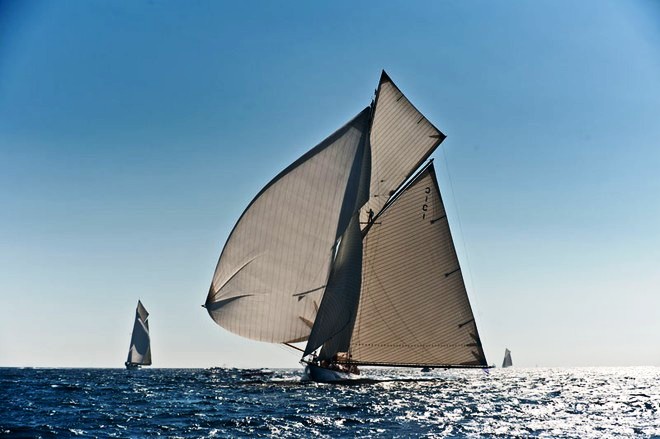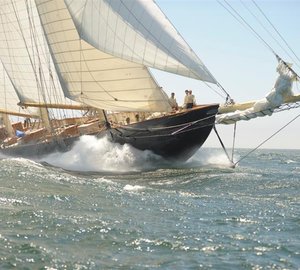First coastal for the seventy seven Classic Yachts of the Régates Royales – Trophée Panerai and three races in a row for the sixtythree Dragons, in ideal wind conditions.
Wind is like grapes, it needs time to get better. This is why the teams had to wait to see this 32nd edition of the Régates Royales – Trophée Panerai start. Sea breeze set in around noon allowing Dragons and Classic yachts to race in nearly perfect conditions: a southerly eight knots, flat sea, and summer like temperatures. As it happened yesterday the Dragons sailed much contested races and the Committee was forced to hoist the black flag (any competitors over the line at the start is disqualified) on all the starts. The classic yachts’ start was also pretty cluttered, and the tension palpable, until the Race officers finally fired the cannon.
It’s thanks to a good breeze, of around 8 knots and increasing during the afternoon to reach a solid fifteen knots, the crews were able to use all their weapons: mainsails, mizzens, gennakers, ballons jibs, spinnakers, stay sails and many others were displayed between Cannes and the Pointe de l’Esquillon. Despite the magnificent show it was a real battle on the water. In the Classic gaffers C class in was the Italian Bona Fide to cress the line in first, but had to leave the victory in corrected time to Oriole (Francis van de Velde) shortly followed by the oldest boat in the fleet, Marigold (Jason Gouldstone).
Pool of biodiversity
As it happened last year, WWF-France -which president is famous French female solo sailor Isabelle Autissier- is a welcomed presence at the Régate Royales – Trophée Panerai 2010 and its ambassador boat, Columbus, skippered by Jean-Yves Terlain is moored among racing boats. From Wednesday to Friday a round of conferences has been organised to inform the public about the marine environment and the consequences of intensive fishing in the Mediterranean, that is to say the second maritime and coastal biodiversity pool in the world. Red Tuna population has decreased by 80%, 19 species of cetaceans are listed in the Ligurian Sea, waste management causes more and more recycling issues. Speaker Charles Braine will animate the conferences, which will be open to the public, on the Régates Royales village.
Atlantic vs Créole?
Friday will be the theatre of a truly historical match: the replica of the famous Schooner Atlantic will sail for the first time in Cannes. The 69,24 metres long yacht helmed by Charlie Barr back in 1905 for the Kaiser’s Cup sadly finished her life in New York in 1982. But the incredible energy of Ed Kastelein and four years of intense work brought the schooner back to life. Créole, Charles Nicholson’s designed and 65,30 metres long three masts, moored in Cannes for years, could duel with the legendary yacht on a breezy day. What a magical match that could be!
Weather forecast
A high pressure is still hovering on the bay of Cannes, with a low pressure gradient. As a result the wind will be light westerly in the morning, veering to southerly around noon and later on a westerly sea breeze of around 5/9 knots will set in. Flat seas and clear skies with temperatures not exceeding 25°C. The weather on Thursday should remain mostly the same yet it is likely to get worse on Friday. A low pressure coming from the North-West will produce fairly strong to strong winds, cloudy sky and occasionally some rain.
Fire and flames
Trying to beat Olin Stephens’ supremacy, Briton Charles E. Nicholson got inspiration from the American’s 12M to build several yachts conceived for offshore racing, the Fastnet and Bermuda Race in the thirties. Firebird X is the fourth boat built for Ralph Haws, a member of the Royal Ocean Racing Club in Cowes.
By designing Dorade and Stormy Wheather Olin Stephens proves that US designers are still untouchable as far as America’s Cup or offshore racing boats are concerned. That’s particularly true in the period prior to the Second World War, when British yachtsmen chose to downscale from J Class boats to 12M for the Cup and the racing/cruising yachts between fifteen and twenty metres, the perfect size for short-handed crews and offshore events that keep growing all over the world.
Yet, the British Yacht Clubs’ members can’t just sit and watch the Americans getting all their trophies, like Dorade winning the Fastnet in 1931 and 1933. When he designs Foxhoun, a 19.30 metres long Marconi cutter for Isaac Bell in 1935, Charles E. Nicholson is the most celebrated architect in the United Kingdom. Finishing fourth in the Fastnet Race, the owner decides to have a yawl built. Bloodhound is soon going to win the Channel Race, the Morgan Cup, and the Fastnet Race…
Eight owners, four names.
Following this hugely successful boat, in 1937 other yachtsmen opt to have Nicholson’s designed boats like Firebird X built at Camper & Nicholson shipyard. Plan number 447 by Charles E. Nicholson is developed on existing rules and on RORC president Ralph Hawks’ racing schedule. The concept is simple: a moderate overhang, a huge draft, a deep, strongly V-shaped hull and a large cutter sail area with a bowsprit. The construction is pretty sophisticated for the time: the boats’ deck is made of teak, the interiors in oak wood with steel reinforced chain plates. Yet, Firebird X is not going to be on the podium in the1937 Fastnet Race which is won by the Dutch Zeearend, another Stephens’ designed yacht! The owner then decides to heavily modify the boat transforming her into a yawl, but only gets to win the German Race on the Baltic Sea. The owners keep alternating as do performances: Mr Crankshaw, Mr Green and in 1962 Frenchman Pierre Cointreau, who re-launches the boat as Flame II in La Trinité sur Mer, where she is one of the biggest yachts moored in a still tiny newborn marina.
Bought by MP Henri Rey in 1970, and still a yawl, the yacht is renamed Vindilis II and is taken to the Med for the season but, while being delivered back to Brittany falls victim of a devastating storm that damages and forces her to stop in Pont l’Abbé at the Pichavant shipyards for repairs. Michel Perroud is her next owner, buys her in 1973 and calls her Oiseau de feu, cruising in the Atlantic from the Azores to Ireland, Scotland and Spain. During a winter storm the boats runs aground on a oyster farm… she needs extensive repairs once more and, this time, the restoration is made at the Naval Arsenal in Lorient before being bought by Pierre Lembo in 1989 who takes her to Saint-Malo for a general refit, to change the corroded metal parts and make a new pinewood deck.
Cannes is my home now
Oiseau de feu new owner is Jean-Philippe L’Huiller, who says: “It’s a very comfortable cruising boat, you can sail single or short-handed. We did keep the mainmast but took the mizzen away because it had no impact on the racing performances upwind. The sail area is smaller but she is a very good boat in strong breeze. We sail mostly in the Med because her home is in Cannes now.”
Oiseau de feu
Designer: Charles E. Nicholson
Builder: Camper & Nicholson
Launch date: 1937
Overall length: 20,74 m
Waterline length: 14,63 m
Width: 3,96 m
Draft: 2,51 m
Displacement: 38 000 kg
Upwind sail area: 211 sqm





















